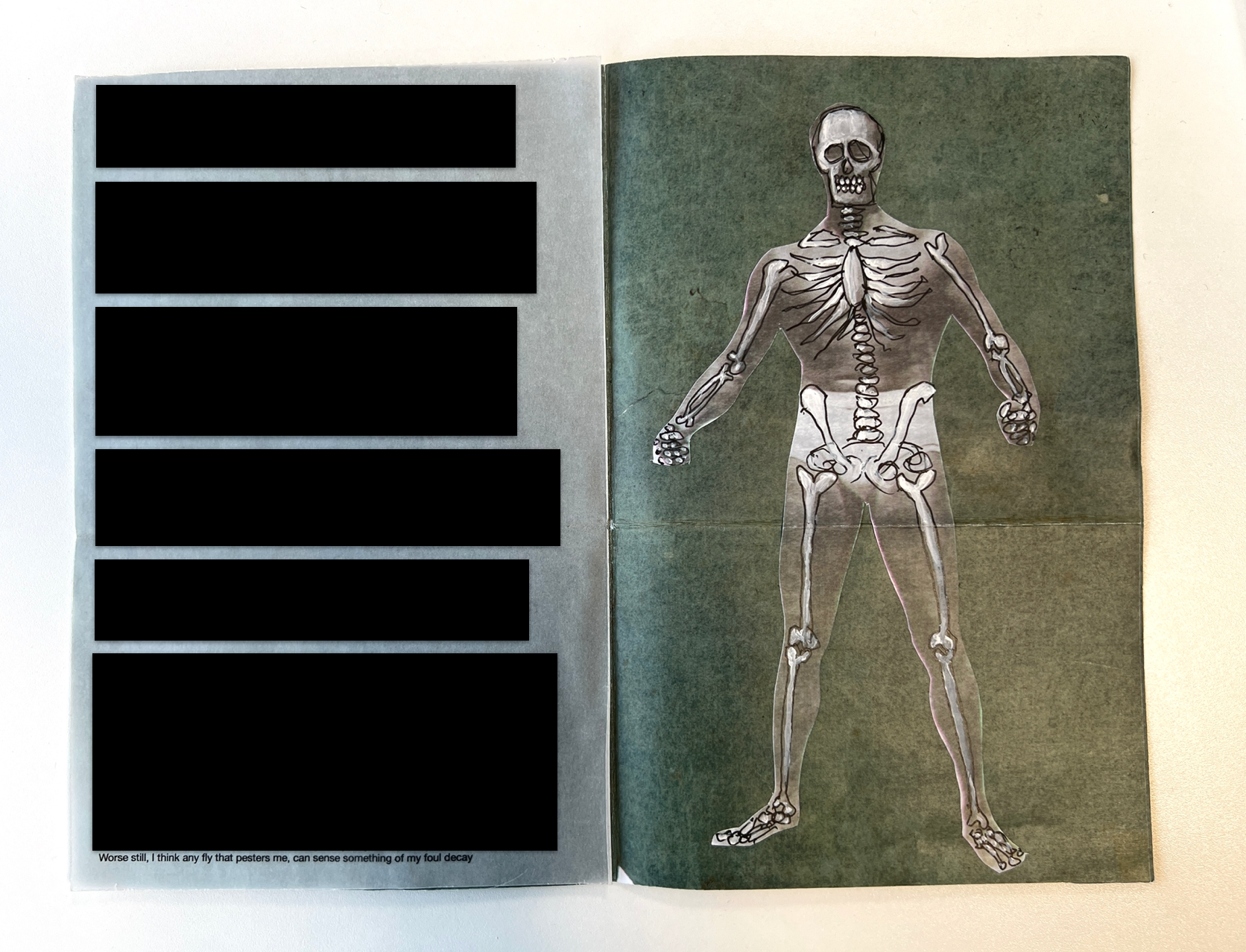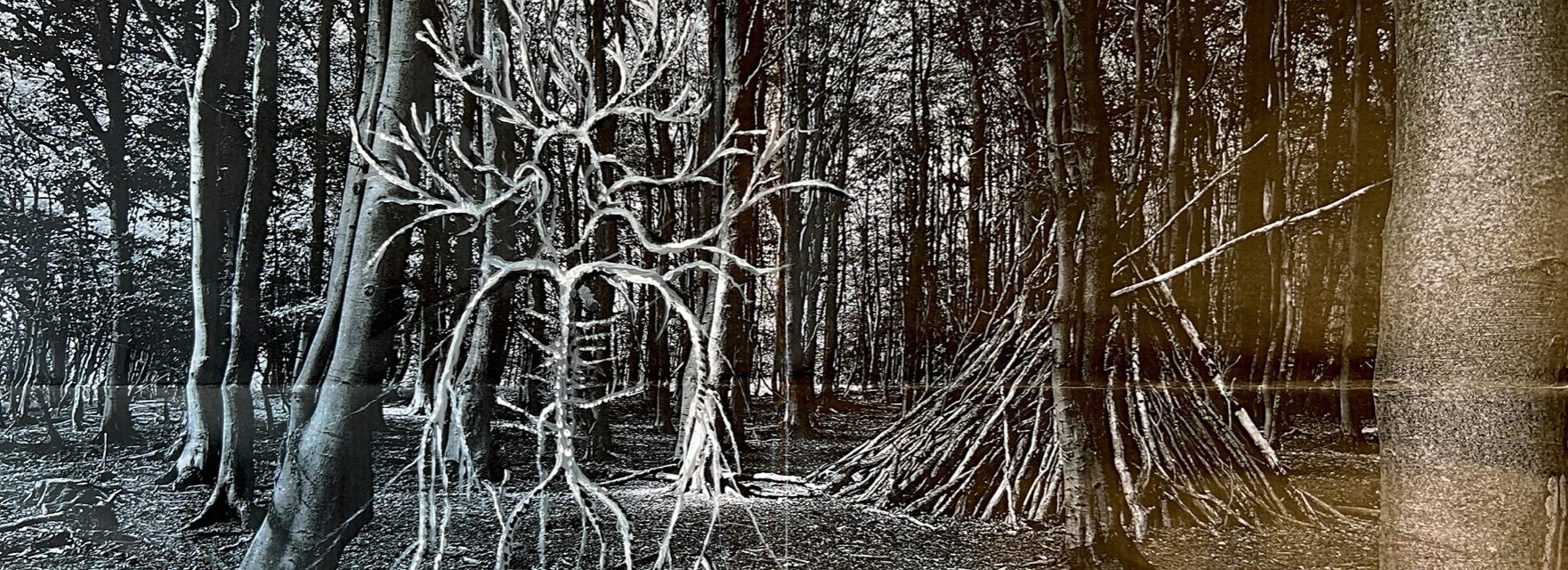Image: The Spirit of Dalton Crags Woodland, 2023. The rear side of a letter and self-portrait of an imagined future ghost, based on an 18th century engraving of the arteries in Diderot’s Encyclopaedia 1751/1772. © Clive Parkinson 2023
This blog was originally shared as part of the opening event for Creativity & Wellbeing Week, on 20 May 2024
Not so very long ago - I walked side by side with my brother Mark, down the long arterial corridor of a grim Victorian asylum. In the 1980s it served the mental health needs of our local community and he’d been recently sectioned. Those days were full of damaging diagnoses, and even more damaging treatments.
Along this corridor, the community arts team had created a mural that stretched for hundreds of yards - covering walls, ceilings - in truth, the corridor was now even more oppressive, with its browns and oranges and greens. Naturally, we preferred to walk through the grounds and not the interior.
Over the same period, I worked in the city’s other asylum - a hospital for people with learning differences - but what tyranny of labels were thrown at people then! But I was lucky - I’d landed on my feet and ran an arts studio in the hospital that linked up with cultural organisations outside this gated community.
At that time, I never thought of what I did in terms of arts and health, or creative health - I just enabled very marginalised people to do creative stuff - and yes, it had an impact on behaviour, so the hospital loved it. However, this wasn’t my intention, but a rather obvious byproduct of being more than just a ‘patient’; and when people could work together, an altogether different thing happened: community.
Very soon I was persuading the local theatre, the Literature Festival, Ludus Dance Company and the newly opened Tate Liverpool, to hit the road and work with us - and it was like nutrition to us all - something far more than the imposition of an ill-conceived mural was being opened up to us.
If I close my eyes, those experiences are like some kind of dream to me.
I can’t quite believe the time I lived through - and if I open my eyes, in the here and now - it’s like some alchemy has happened. I applaud the intention and work that’s gone into the development of both the Creative Health Quality Framework and its Quality Principles and the Creative Health Toolkit.
So many more people understand that the arts in all their forms can have a transformational effect on their lives. Those people who called for a ‘scaling up’ this community of practice, are witnessing what we might look back on as a renaissance in ‘creative health’ - with universities offering new courses, clinicians seeing the value within their communities and funders investing more in this field. The evolution of the Culture, Health and Wellbeing Alliance; the blossoming of networks; the development of the National Centre for Creative Health - these are all things I couldn’t have imagined in the early '80s in that segregated hospital community.
But are we really being funded more - or are artists of all disciplines and small arts organisations being seen as cheap or free alternatives to keep the poorly and impoverished masses placated and quiet? Perhaps this burgeoning creative agenda might unintentionally become part of the ongoing privatisation of our health and care.
Being seen as part of time-limited nanny-state solutions, runs the risk of turning people off getting involved. There’s a danger too, of organisational marketeers making glossy claims that their work impacts on health and wellbeing, simply to get the funding - large and slippery organisations might soak up the funds - the smaller and less agile arts groupings maybe less able to compete.
We need to keep a critical eye on those who seek out our collaborations and understand their motivations. Many years ago, the CEO of the NHS declared - that we need to harness the renewable energy of our communities. I liked that - and we do; but we also need to nurture and care for the voices that might challenge our ways of being and doing. We need to keep networking, talking and listening - and not just to the most vocal - but critically, the people and groups with the quietest voices.
How many people are invisible to us? What skills and experiences are hidden away in flats and houses, prisons and on the streets.
To address the inequities that underpin public health, our shared intersectional role is to assertively resist stagnant attitudes and explore the untapped possibilities of neighbourhoods and communities. There’s ample research around impact too - and it needs sharing more broadly in ways that are useful.
The world is messed up - we are governed by barbarians in sharp suits - too often we see that leadership doesn’t listen. Our collective outrage might learn from the direct-action of the past.
But here and now, there is much I gain hope from, and the values and direction of arts, health and social action charity, Queer Circle capture something key for me:
“We believe in the radical potential of the arts for individual, collective and societal transformation.”
That is all I can hope for, it’s simple, and it should drive us all.
Images
Over 2023 Clive Parkinson and the writer Jenn Ashworth collaborated on a project exploring walking, care and mortality. As she undertook a solo walk from St Bees in Cumbria to Robin Hood’s Bay in Yorkshire, each evening when she arrived at her bed and breakfast, she received a small package from Clive which contained a letter - part story, part artefact. In return, she would send him small films and sound files. Between the two of them, they created an exquisite corpse, or sorts. In spring 2025, Jenn Ashworth’s book, which is an account of this walk will be published by Sceptre. The two images in this text were part of this unusual correspondence.

My Foul Decay, 2023. Redacted letter using collaged materials from the Charles Atlas Dynamic Tension program. © Clive Parkinson 2023
Dr Clive Parkinson was the Director of Arts for Health for 17 years and is Honorary Chair of Creative Health and Social Change at Manchester University. He has been closely involved with arts and health developments in the UK, Europe and Australia. Working collectively with people affected by substance use across Europe, he published the Recoverist Manifesto (2014). His performative work dis/ordered (2017) performed at the Museum of Contemporary Art in Sydney, explored mental difference and his short film, A Gentle Haunting (2020) utilised mobile phone footage made while walking out during lock-down, which was in part, a response to his diagnosis of multiple-myeloma. He wrote A Social Glue for Greater Manchester Combined Authority in 2020, which set out aspirations for Greater Manchester to become the UK’s first Creative Health City Region. He is currently collaborating with the writer Jenn Ashworth on an exploration of walking, care and mortality.

